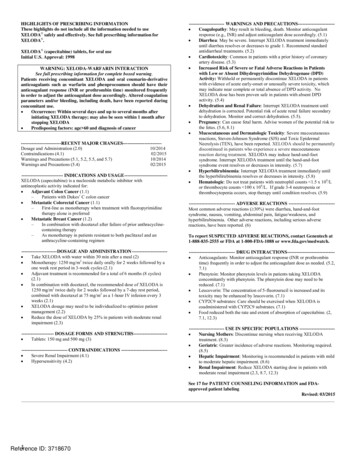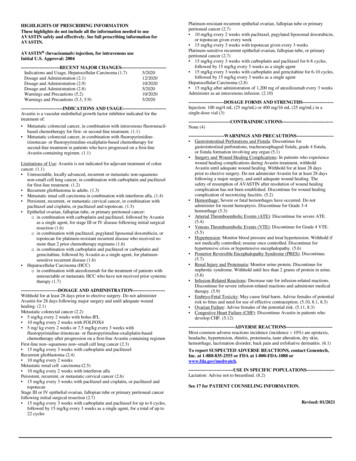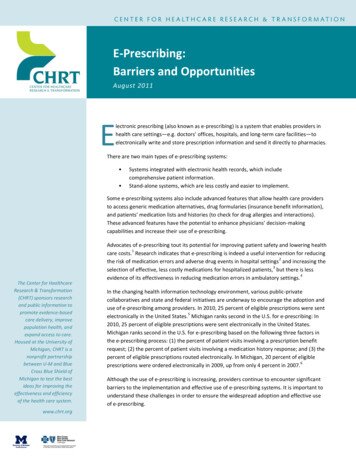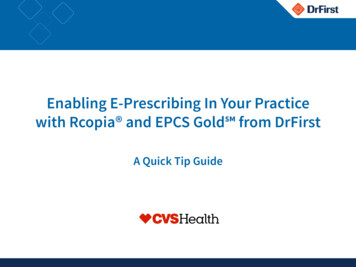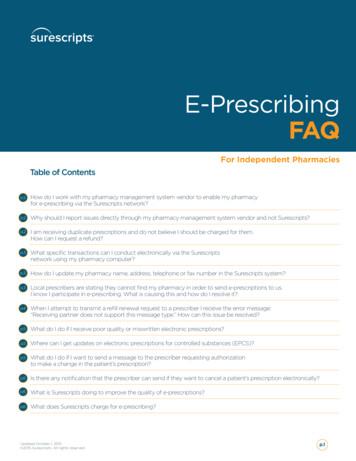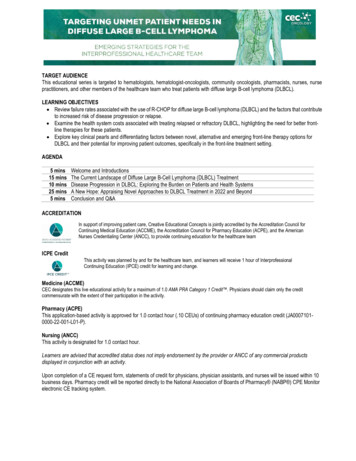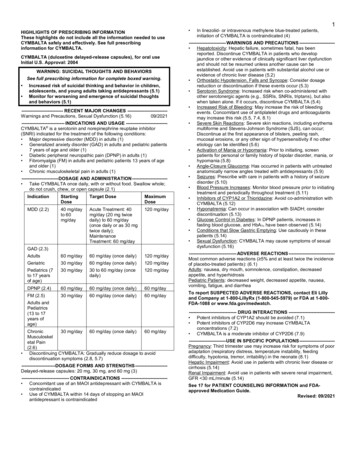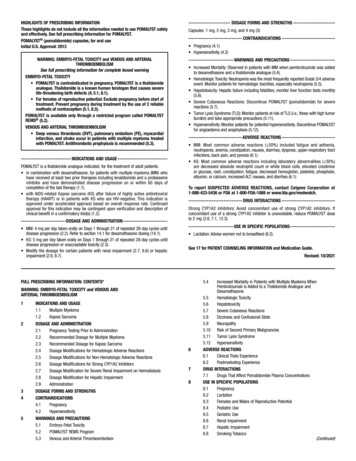
Transcription
HIGHLIGHTS OF PRESCRIBING INFORMATIONThese highlights do not include all the information needed to useXELODA safely and effectively. See full prescribing information forXELODA .XELODA (capecitabine) tablets, for oral useInitial U.S. Approval: 1998WARNING: XELODA-WARFARIN INTERACTIONSee full prescribing information for complete boxed warning.Patients receiving concomitant XELODA and oral coumarin-derivativeanticoagulants such as warfarin and phenprocoumon should have theiranticoagulant response (INR or prothrombin time) monitored frequentlyin order to adjust the anticoagulant dose accordingly. Altered coagulationparameters and/or bleeding, including death, have been reported duringconcomitant use. Occurrence: Within several days and up to several months afterinitiating XELODA therapy; may also be seen within 1 month afterstopping XELODA Predisposing factors: age 60 and diagnosis of cancer--------------------------- INDICATIONS AND USAGE---------------------------XELODA (capecitabine) is a nucleoside metabolic inhibitor withantineoplastic activity indicated for: Adjuvant Colon Cancer (1.1)–Patients with Dukes’ C colon cancer Metastatic Colorectal Cancer (1.1)–First-line as monotherapy when treatment with fluoropyrimidinetherapy alone is preferred Metastatic Breast Cancer (1.2)–In combination with docetaxel after failure of prior anthracyclinecontaining therapy–As monotherapy in patients resistant to both paclitaxel and ananthracycline-containing regimen-----------------------DOSAGE AND ADMINISTRATION ---------------------- Take XELODA with water within 30 min after a meal (2.1) Monotherapy: 1250 mg/m2 twice daily orally for 2 weeks followed by aone week rest period in 3-week cycles (2.2) Adjuvant treatment is recommended for a total of 6 months (8 cycles)(2.2) In combination with docetaxel, the recommended dose of XELODA is1250 mg/m2 twice daily for 2 weeks followed by a 7-day rest period,combined with docetaxel at 75 mg/m2 as a 1-hour IV infusion every 3weeks (2.2) XELODA dosage may need to be individualized to optimize patientmanagement (2.3) Reduce the dose of XELODA by 25% in patients with moderate renalimpairment (2.4)--------------------- DOSAGE FORMS AND STRENGTHS--------------------- Tablets: 150 mg and 500 mg (3)------------------------------ CONTRAINDICATIONS ----------------------------- Severe Renal Impairment (4.1) Hypersensitivity (4.2)----------------------- WARNINGS AND PRECAUTIONS ---------------------- Coagulopathy: May result in bleeding, death. Monitor anticoagulantresponse (e.g., INR) and adjust anticoagulant dose accordingly. (5.1) Diarrhea: May be severe. Interrupt XELODA treatment immediatelyuntil diarrhea resolves or decreases to grade 1. Recommend standardantidiarrheal treatments. (5.2) Cardiotoxicity: Common in patients with a prior history of coronaryartery disease. (5.3) Increased Risk of Severe or Fatal Adverse Reactions in Patientswith Low or Absent Dihydropyrimidine Dehydrogenase (DPD)Activity: Withhold or permanently discontinue XELODA in patientswith evidence of acute early-onset or unusually severe toxicity, whichmay indicate near complete or total absence of DPD activity. NoXELODA dose has been proven safe in patients with absent DPDactivity. (5.4) Dehydration and Renal Failure: Interrupt XELODA treatment untildehydration is corrected. Potential risk of acute renal failure secondaryto dehydration. Monitor and correct dehydration. (5.5). Embryo-Fetal Toxicity: Can cause fetal harm. Advise females ofreproductive potential of the potential risk to a fetus and to use effectivecontraception. (5.6, 8.1, 8.3) Mucocutaneous and Dermatologic Toxicity: Severe mucocutaneousreactions, Steven-Johnson Syndrome (SJS) and Toxic EpidermalNecrolysis (TEN), have been reported. XELODA should be permanentlydiscontinued in patients who experience a severe mucocutaneousreaction during treatment. XELODA may induce hand-and-footsyndrome. Persistent or severe hand-and-foot syndrome can lead to lossof fingerprints which could impact patient identification. InterruptXELODA treatment until the hand-and-foot syndrome event resolves ordecreases in intensity. (5.7) Hyperbilirubinemia: Interrupt XELODA treatment immediately untilthe hyperbilirubinemia resolves or decreases in intensity. (5.8) Hematologic: Do not treat patients with neutrophil counts 1.5 x 109/Lor thrombocyte counts 100 x 109/L. If grade 3-4 neutropenia orthrombocytopenia occurs, stop therapy until condition resolves. (5.9)------------------------------ ADVERSE REACTIONS -----------------------------Most common adverse reactions ( 30%) were diarrhea, hand-and-footsyndrome, nausea, vomiting, abdominal pain, fatigue/weakness, andhyperbilirubinemia. Other adverse reactions, including serious adversereactions, have been reported. (6)To report SUSPECTED ADVERSE REACTIONS, contact Genentech at1-888-835-2555 or FDA at 1-800-FDA-1088 or - DRUG INTERACTIONS------------------------------ Anticoagulants: Monitor anticoagulant response (INR or prothrombintime) frequently in order to adjust the anticoagulant dose as needed. (5.2,7.1) Phenytoin: Monitor phenytoin levels in patients taking XELODAconcomitantly with phenytoin. The phenytoin dose may need to bereduced. (7.1) Leucovorin: The concentration of 5-fluorouracil is increased and itstoxicity may be enhanced by leucovorin. (7.1) CYP2C9 substrates: Care should be exercised when XELODA iscoadministered with CYP2C9 substrates. (7.1) Allopurinol: Avoid the use of allopurinol during treatment withXELODA. Food reduced both the rate and extent of absorption of capecitabine. (2,7.2, 12.3)----------------------- USE IN SPECIFIC POPULATIONS ---------------------- Lactation: Advise women not to breastfeed. (8.2) Females and Males of Reproductive Potential: Verify pregnancystatus of females prior to initiation of XELODA. Advise males withfemale partners of reproductive potential to use effective contraception.(8.3) Geriatric: Greater incidence of adverse reactions. Monitoring required.(8.5) Hepatic Impairment: Monitoring is recommended in patients with mildto moderate hepatic impairment. (8.6) Renal Impairment: Reduce XELODA starting dose in patients withmoderate renal impairment (2.4, 8.7, 12.3)See 17 for PATIENT COUNSELING INFORMATION and FDAapproved patient labelingRevised: 05/20211
FULL PRESCRIBING INFORMATION: CONTENTS*WARNING: XELODA-WARFARIN INTERACTION1 INDICATIONS AND USAGE1.1 Colorectal Cancer1.2 Breast Cancer2 DOSAGE AND ADMINISTRATION2.1 Important Administration Instructions2.2 Standard Starting Dose2.3 Dose Management Guidelines2.4 Adjustment of Starting Dose in Special Populations3 DOSAGE FORMS AND STRENGTHS4 CONTRAINDICATIONS4.1 Severe Renal Impairment4.2 Hypersensitivity5 WARNINGS AND PRECAUTIONS5.1 Coagulopathy5.2 Diarrhea5.3 Cardiotoxicity5.4 Dihydropyrimidine Dehydrogenase Deficiency5.5 Dehydration and Renal Failure5.6 Embryo-Fetal Toxicity5.7 Mucocutaneous and Dermatologic Toxicity5.8 Hyperbilirubinemia5.9 Hematologic5.10 Geriatric Patients5.11 Hepatic Insufficiency5.12 Combination With Other Drugs6 ADVERSE REACTIONS6.1 Adjuvant Colon Cancer6.2 Metastatic Colorectal Cancer6.3 Breast Cancer27810111213141516176.4 Clinically Relevant Adverse Events in 5% of Patients6.5 Postmarketing ExperienceDRUG INTERACTIONS7.1 Drug-Drug Interactions7.2 Drug-Food InteractionUSE IN SPECIFIC POPULATIONS8.1 Pregnancy8.2 Lactation8.3 Females and Males of Reproductive Potential8.4 Pediatric Use8.5 Geriatric Use8.6 Hepatic Insufficiency8.7 Renal InsufficiencyOVERDOSAGEDESCRIPTIONCLINICAL PHARMACOLOGY12.1 Mechanism of Action12.3 PharmacokineticsNONCLINICAL TOXICOLOGY13.1 Carcinogenesis, Mutagenesis, Impairment of FertilityCLINICAL STUDIES14.1 Adjuvant Colon Cancer14.2 Metastatic Colorectal Cancer14.3 Breast CancerREFERENCESHOW SUPPLIED/STORAGE AND HANDLINGPATIENT COUNSELING INFORMATION*Sections or subsections omitted from the full prescribing information are notlisted.
FULL PRESCRIBING INFORMATIONWARNING: XELODA-WARFARIN INTERACTIONXELODA Warfarin Interaction: Patients receiving concomitant capecitabine and oralcoumarin-derivative anticoagulant therapy should have their anticoagulant response (INRor prothrombin time) monitored frequently in order to adjust the anticoagulant doseaccordingly. A clinically important XELODA-Warfarin drug interaction wasdemonstrated in a clinical pharmacology trial [see Warnings and Precautions (5.2) andDrug Interactions (7.1)]. Altered coagulation parameters and/or bleeding, including death,have been reported in patients taking XELODA concomitantly with coumarin-derivativeanticoagulants such as warfarin and phenprocoumon. Postmarketing reports have shownclinically significant increases in prothrombin time (PT) and INR in patients who werestabilized on anticoagulants at the time XELODA was introduced. These events occurredwithin several days and up to several months after initiating XELODA therapy and, in afew cases, within 1 month after stopping XELODA. These events occurred in patients withand without liver metastases. Age greater than 60 and a diagnosis of cancer independentlypredispose patients to an increased risk of coagulopathy.1INDICATIONS AND USAGE1.1Colorectal Cancer XELODA is indicated as a single agent for adjuvant treatment in patients with Dukes’ Ccolon cancer who have undergone complete resection of the primary tumor when treatmentwith fluoropyrimidine therapy alone is preferred. XELODA was non-inferior to 5fluorouracil and leucovorin (5-FU/LV) for disease-free survival (DFS). Physicians shouldconsider results of combination chemotherapy trials, which have shown improvement in DFSand OS, when prescribing single-agent XELODA in the adjuvant treatment of Dukes’ Ccolon cancer. XELODA is indicated as first-line treatment of patients with metastatic colorectal carcinomawhen treatment with fluoropyrimidine therapy alone is preferred. Combination chemotherapyhas shown a survival benefit compared to 5-FU/LV alone. A survival benefit over 5-FU/LVhas not been demonstrated with XELODA monotherapy. Use of XELODA instead of 5FU/LV in combinations has not been adequately studied to assure safety or preservation ofthe survival advantage.1.2Breast Cancer XELODA in combination with docetaxel is indicated for the treatment of patients withmetastatic breast cancer after failure of prior anthracycline-containing chemotherapy. XELODA monotherapy is also indicated for the treatment of patients with metastatic breastcancer resistant to both paclitaxel and an anthracycline-containing chemotherapy regimen orresistant to paclitaxel and for whom further anthracycline therapy is not indicated (e.g.,patients who have received cumulative doses of 400 mg/m2 of doxorubicin or doxorubicinequivalents). Resistance is defined as progressive disease while on treatment, with or withoutan initial response, or relapse within 6 months of completing treatment with an anthracyclinecontaining adjuvant regimen.3
2DOSAGE AND ADMINISTRATION2.1Important Administration InstructionsXELODA tablets should be swallowed whole with water within 30 minutes after a meal.XELODA is a cytotoxic drug. Follow applicable special handling and disposal procedures.1 IfXELODA tablets must be cut or crushed, this should be done by a professional trained in safehandling of cytotoxic drugs using appropriate equipment and safety procedures. XELODA doseis calculated according to body surface area.2.2Standard Starting DoseMonotherapy (Metastatic Colorectal Cancer, Adjuvant Colorectal Cancer, Metastatic BreastCancer)The recommended dose of XELODA is 1250 mg/m2 administered orally twice daily (morningand evening; equivalent to 2500 mg/m2 total daily dose) for 2 weeks followed by a 1-week restperiod given as 3-week cycles (see Table 1).Adjuvant treatment in patients with Dukes’ C colon cancer is recommended for a total of 6months [ie, XELODA 1250 mg/m2 orally twice daily for 2 weeks followed by a 1-week restperiod, given as 3-week cycles for a total of 8 cycles (24 weeks)].Table 1XELODA Dose Calculation According to Body Surface AreaDose Level 1250 mg/m2Number of Tablets to be Taken atTwice a DayEach Dose (Morning and Evening)Surface AreaTotal Daily150 mg500 mg2(m )Dose* (mg)300003 .17530015560025 2.18*Total Daily Dose divided by 2 to allow equal morning and evening dosesIn Combination With Docetaxel (Metastatic Breast Cancer)In combination with docetaxel, the recommended dose of XELODA is 1250 mg/m2 twice dailyfor 2 weeks followed by a 1-week rest period, combined with docetaxel at 75 mg/m2 as a 1-hourintravenous infusion every 3 weeks. Pre-medication, according to the docetaxel labeling, shouldbe started prior to docetaxel administration for patients receiving the XELODA plus docetaxelcombination. Table 1 displays the total daily dose of XELODA by body surface area and thenumber of tablets to be taken at each dose.4
2.3Dose Management GuidelinesGeneralXELODA dosage may need to be individualized to optimize patient management. Patientsshould be carefully monitored for toxicity and doses of XELODA should be modified asnecessary to accommodate individual patient tolerance to treatment [see Clinical Studies (14)].Toxicity due to XELODA administration may be managed by symptomatic treatment, doseinterruptions and adjustment of XELODA dose. Once the dose has been reduced, it should not beincreased at a later time. Doses of XELODA omitted for toxicity are not replaced or restored;instead the patient should resume the planned treatment cycles.The dose of phenytoin and the dose of coumarin-derivative anticoagulants may need to bereduced when either drug is administered concomitantly with XELODA [see Drug Interactions(7.1)].Monotherapy (Metastatic Colorectal Cancer, Adjuvant Colorectal Cancer, Metastatic BreastCancer)XELODA dose modification scheme as described below (see Table 2) is recommended for themanagement of adverse reactions.Table 2ToxicityNCIC Grades*Grade 1Recommended Dose Modifications of XELODADuring a Course of TherapyDose Adjustment for NextTreatment (% of starting dose)Maintain dose levelMaintain dose levelGrade 2-1st appearance-2nd appearance-3rd appearance-4th appearanceInterrupt until resolved to grade 0-1Discontinue treatment permanently100%75%50%-Grade 3-1st appearance-2nd appearance-3rd appearanceInterrupt until resolved to grade 0-1Discontinue treatment permanently75%50%-Grade 4-1st appearanceDiscontinue permanently50%ORIf physician deems it to be in thepatient’s best interest to continue,interrupt until resolved to grade 0-1*National Cancer Institute of Canada Common Toxicity Criteria were used except for the hand-and-foot syndrome[see Warnings and Precautions (5)].In Combination With Docetaxel (Metastatic Breast Cancer)Dose modifications of XELODA for toxicity should be made according to Table 2 above forXELODA. At the beginning of a treatment cycle, if a treatment delay is indicated for eitherXELODA or docetaxel, then administration of both agents should be delayed until therequirements for restarting both drugs are met.5
The dose reduction schedule for docetaxel when used in combination with XELODA for thetreatment of metastatic breast cancer is shown in Table 3.Table 3ToxicityDocetaxel Dose Reduction Schedule in Combination with XELODAGrade 2Grade 3Grade 4NCIC Grades*1st appearanceDelay treatment untilDelay treatment untilDiscontinue treatmentresolved to grade 0-1;resolved to grade 0-1;with docetaxelResume treatment withResume treatment atoriginal dose of 75 mg/m255 mg/m2 of docetaxel.docetaxel2nd appearanceDelay treatment untilDiscontinue treatmentresolved to grade 0-1;with docetaxelResume treatment at55 mg/m2 of docetaxel.3rd appearanceDiscontinue treatment withdocetaxel*National Cancer Institute of Canada Common Toxicity Criteria were used except for hand-and-foot syndrome [seeWarnings and Precautions (5)].2.4Adjustment of Starting Dose in Special PopulationsRenal ImpairmentNo adjustment to the starting dose of XELODA is recommended in patients with mild renalimpairment (creatinine clearance 51 to 80 mL/min [Cockroft and Gault, as shown below]). Inpatients with moderate renal impairment (baseline creatinine clearance 30 to 50 mL/min), adose reduction to 75% of the XELODA starting dose when used as monotherapy or incombination with docetaxel (from 1250 mg/m2 to 950 mg/m2 twice daily) is recommended [seeUse in Specific Populations (8.7) and Clinical Pharmacology (12.3)]. Subsequent doseadjustment is recommended as outlined in Table 2 and Table 3 (depending on the regimen) if apatient develops a grade 2 to 4 adverse event [see Warnings and Precautions (5.5)]. The startingdose adjustment recommendations for patients with moderate renal impairment apply to bothXELODA monotherapy and XELODA in combination use with docetaxel.Cockroft and Gault Equation:(140 - age [yrs]) (body wt [kg])Creatinine clearance for males —————————————(72) (serum creatinine [mg/dL])Creatinine clearance for females 0.85 x male valueGeriatricsPhysicians should exercise caution in monitoring the effects of XELODA in the elderly.Insufficient data are available to provide a dosage recommendation.6
3DOSAGE FORMS AND STRENGTHSXELODA is supplied as biconvex, oblong film-coated tablets for oral administration. Each lightpeach-colored tablet contains 150 mg of capecitabine and each peach-colored tablet contains 500mg of capecitabine.4CONTRAINDICATIONS4.1Severe Renal ImpairmentXELODA is contraindicated in patients with severe renal impairment (creatinine clearancebelow 30 mL/min [Cockroft and Gault]) [see Use in Specific Populations (8.7) and ClinicalPharmacology (12.3)].4.2HypersensitivityXELODA is contraindicated in patients with known hypersensitivity to capecitabine or to any ofits components. XELODA is contraindicated in patients who have a known hypersensitivity to 5fluorouracil.5WARNINGS AND PRECAUTIONS5.1CoagulopathyPatients receiving concomitant capecitabine and oral coumarin-derivative anticoagulant therapyshould have their anticoagulant response (INR or prothrombin time) monitored closely with greatfrequency and the anticoagulant dose should be adjusted accordingly [see Boxed Warning andDrug Interactions (7.1)].5.2DiarrheaXELODA can induce diarrhea, sometimes severe. Patients with severe diarrhea should becarefully monitored and given fluid and electrolyte replacement if they become dehydrated. In875 patients with either metastatic breast or colorectal cancer who received XELODAmonotherapy, the median time to first occurrence of grade 2 to 4 diarrhea was 34 days (rangefrom 1 to 369 days). The median duration of grade 3 to 4 diarrhea was 5 days. National CancerInstitute of Canada (NCIC) grade 2 diarrhea is defined as an increase of 4 to 6 stools/day ornocturnal stools, grade 3 diarrhea as an increase of 7 to 9 stools/day or incontinence andmalabsorption, and grade 4 diarrhea as an increase of 10 stools/day or grossly bloody diarrheaor the need for parenteral support. If grade 2, 3 or 4 diarrhea occurs, administration of XELODAshould be immediately interrupted until the diarrhea resolves or decreases in intensity to grade 1[see Dosage and Administration (2.3)]. Standard antidiarrheal treatments (e.g., loperamide) arerecommended.Necrotizing enterocolitis (typhlitis) has been reported.5.3CardiotoxicityThe cardiotoxicity observed with XELODA includes myocardial infarction/ischemia, angina,dysrhythmias, cardiac arrest, cardiac failure, sudden death, electrocardiographic changes, andcardiomyopathy. These adverse reactions may be more common in patients with a prior historyof coronary artery disease.5.4Dihydropyrimidine Dehydrogenase DeficiencyBased on postmarketing reports, patients with certain homozygous or certain compound7
heterozygous mutations in the DPD gene that result in complete or near complete absence ofDPD activity are at increased risk for acute early-onset of toxicity and severe, life-threatening,or fatal adverse reactions caused by XELODA (e.g., mucositis, diarrhea, neutropenia, andneurotoxicity). Patients with partial DPD activity may also have increased risk of severe, lifethreatening, or fatal adverse reactions caused by XELODA.Withhold or permanently discontinue XELODA based on clinical assessment of the onset,duration and severity of the observed toxicities in patients with evidence of acute early-onset orunusually severe toxicity, which may indicate near complete or total absence of DPD activity.No XELODA dose has been proven safe for patients with complete absence of DPD activity.There is insufficient data to recommend a specific dose in patients with partial DPD activity asmeasured by any specific test.5.5Dehydration and Renal FailureDehydration has been observed and may cause acute renal failure which can be fatal. Patientswith pre-existing compromised renal function or who are receiving concomitant XELODA withknown nephrotoxic agents are at higher risk. Patients with anorexia, asthenia, nausea, vomitingor diarrhea may rapidly become dehydrated. Monitor patients when XELODA is administered toprevent and correct dehydration at the onset. If grade 2 (or higher) dehydration occurs,XELODA treatment should be immediately interrupted and the dehydration corrected. Treatmentshould not be restarted until the patient is rehydrated and any precipitating causes have beencorrected or controlled. Dose modifications should be applied for the precipitating adverse eventas necessary [see Dosage and Administration (2.3)].Patients with moderate renal impairment at baseline require dose reduction [see Dosage andAdministration (2.4)]. Patients with mild and moderate renal impairment at baseline should becarefully monitored for adverse reactions. Prompt interruption of therapy with subsequent doseadjustments is recommended if a patient develops a grade 2 to 4 adverse event as outlined inTable 2 [see Dosage and Administration (2.3), Use in Specific Populations (8.7), and ClinicalPharmacology (12.3)].5.6Embryo-Fetal ToxicityBased on findings from animal reproduction studies and its mechanism of action, XELODA maycause fetal harm when given to a pregnant woman [see Clinical Pharmacology (12.1)]. Limitedavailable data are not sufficient to inform use of XELODA in pregnant women. In animalreproduction studies, administration of capecitabine to pregnant animals during the period oforganogenesis caused embryolethality and teratogenicity in mice and embryolethality inmonkeys at 0.2 and 0.6 times the exposure (AUC) in patients receiving the recommended doserespectively [see Use in Specific Populations (8.1)]. Apprise pregnant women of the potentialrisk to a fetus. Advise females of reproductive potential to use effective contraception duringtreatment and for 6 months following the last dose of XELODA [see Use in Specific Populations(8.3)].5.7Mucocutaneous and Dermatologic ToxicitySevere mucocutaneous reactions, some with fatal outcome, such as Stevens-Johnson syndromeand Toxic Epidermal Necrolysis (TEN) can occur in patients treated with XELODA [see8
Adverse Reactions (6.4)]. XELODA should be permanently discontinued in patients whoexperience a severe mucocutaneous reaction possibly attributable to XELODA treatment.Hand-and-foot syndrome (palmar-plantar erythrodysesthesia or chemotherapy-induced acralerythema) is a cutaneous toxicity. Median time to onset was 79 days (range from 11 to 360 days)with a severity range of grades 1 to 3 for patients receiving XELODA monotherapy in themetastatic setting. Grade 1 is characterized by any of the following: numbness,dysesthesia/paresthesia, tingling, painless swelling or erythema of the hands and/or feet and/ordiscomfort which does not disrupt normal activities. Grade 2 hand-and-foot syndrome is definedas painful erythema and swelling of the hands and/or feet and/or discomfort affecting thepatient’s activities of daily living. Grade 3 hand-and-foot syndrome is defined as moistdesquamation, ulceration, blistering or severe pain of the hands and/or feet and/or severediscomfort that causes the patient to be unable to work or perform activities of daily living.Persistent or severe hand-and-foot syndrome (grade 2 and above) can eventually lead to loss offingerprints which could impact patient identification. If grade 2 or 3 hand-and-foot syndromeoccurs, administration of XELODA should be interrupted until the event resolves or decreases inintensity to grade 1. Following grade 3 hand-and-foot syndrome, subsequent doses of XELODAshould be decreased [see Dosage and Administration (2.3)].5.8HyperbilirubinemiaIn 875 patients with either metastatic breast or colorectal cancer who received at least one doseof XELODA 1250 mg/m2 twice daily as monotherapy for 2 weeks followed by a 1-week restperiod, grade 3 (1.5-3 x ULN) hyperbilirubinemia occurred in 15.2% (n 133) of patients andgrade 4 ( 3 x ULN) hyperbilirubinemia occurred in 3.9% (n 34) of patients. Of 566 patientswho had hepatic metastases at baseline and 309 patients without hepatic metastases at baseline,grade 3 or 4 hyperbilirubinemia occurred in 22.8% and 12.3%, respectively. Of the 167 patientswith grade 3 or 4 hyperbilirubinemia, 18.6% (n 31) also had postbaseline elevations (grades 1 to4, without elevations at baseline) in alkaline phosphatase and 27.5% (n 46) had postbaselineelevations in transaminases at any time (not necessarily concurrent). The majority of thesepatients, 64.5% (n 20) and 71.7% (n 33), had liver metastases at baseline. In addition, 57.5%(n 96) and 35.3% (n 59) of the 167 patients had elevations (grades 1 to 4) at both prebaselineand postbaseline in alkaline phosphatase or transaminases, respectively. Only 7.8% (n 13) and3.0% (n 5) had grade 3 or 4 elevations in alkaline phosphatase or transaminases.In the 596 patients treated with XELODA as first-line therapy for metastatic colorectal cancer,the incidence of grade 3 or 4 hyperbilirubinemia was similar to the overall clinical trial safetydatabase of XELODA monotherapy. The median time to onset for grade 3 or 4hyperbilirubinemia in the colorectal cancer population was 64 days and median total bilirubinincreased from 8 m/L at baseline to 13 m/L during treatment with XELODA. Of the 136colorectal cancer patients with grade 3 or 4 hyperbilirubinemia, 49 patients had grade 3 or 4hyperbilirubinemia as their last measured value, of which 46 had liver metastases at baseline.In 251 patients with metastatic breast cancer who received a combination of XELODA anddocetaxel, grade 3 (1.5 to 3 x ULN) hyperbilirubinemia occurred in 7% (n 17) and grade 4 ( 3 xULN) hyperbilirubinemia occurred in 2% (n 5).9
If drug-related grade 3 to 4 elevations in bilirubin occur, administration of XELODA should beimmediately interrupted until the hyperbilirubinemia decreases to 3.0 X ULN [seerecommended dose modifications under Dosage and Administration (2.3)].5.9HematologicIn 875 patients with either metastatic breast or colorectal cancer who received a dose of 1250mg/m2 administered twice daily as monotherapy for 2 weeks followed by a 1-week rest period,3.2%, 1.7%, and 2.4% of patients had grade 3 or 4 neutropenia, thrombocytopenia or decreasesin hemoglobin, respectively. In 251 patients with metastatic breast cancer who received a dose ofXELODA in combination with docetaxel, 68% had grade 3 or 4 neutropenia, 2.8% had grade 3or 4 thrombocytopenia, and 9.6% had grade 3 or 4 anemia.Patients with baseline neutrophil counts of 1.5 x 109/L and/or thrombocyte counts of 100 x109/L should not be treated with XELODA. If unscheduled laboratory assessments during atreatment cycle show grade 3 or 4 hematologic toxicity, treatment with XELODA should beinterrupted.5.10Geriatric PatientsPatients 80 years old may experience a greater incidence of grade 3 or 4 adverse reactions. In875 patients with either metastatic breast or colorectal cancer who received XELODAmonotherapy, 62% of the 21 patients 80 years of age treated with XELODA experienced atreatment-related grade 3 or 4 adverse event: diarrhea in 6 (28.6%), nausea in 3 (14.3%), handand-foot syndrome in 3 (14.3%), and vomiting in 2 (9.5%) patients. Among the 10 patients 70years of age and greater (no patients were 80 years of age) treated with XELODA incombination with docetaxel, 30% (3 out of 10) of patients experienced grade 3 or 4 diarrhea andstomatitis, and 40% (4 out of 10) experienced grade 3 hand-and-foot syndrome.Among the 67 patients 60 years of age receiving XELODA in combination with docetaxel, theincidence of grade 3 or 4 treatment-related adverse reactions, treatment-related serious adversereactions, withdrawals due to adverse reactions, treatment discontinuations due to adversereactions and treatment discontinuations within the first two treatment cycles was higher than inthe 60 years of age patient group.In 995 patients receiving XELODA as adjuvant therapy for Dukes’ C colon cancer afterresection of the primary tumor, 41% of the 398 patients 65 years of age treated with XELODAexperienced a treatment-related grade 3 or 4 adverse event: hand-and-foot syndrome in 75(18.8%), diarrhea in 52 (13.1%), stomatitis in 12 (3.0%), neutropenia/granulocytopenia in 11(2.8%), vomiting in 6 (1.5%), and nausea in 5 (1.3%) patients. In patients 65 years of age (allrandomized population; capecitabine 188 patients, 5-FU/LV 208 patients) treated for Dukes’ Ccolon cancer after resection of the primary tumor, the hazard ratios for disease-free survival andoverall survival for XELODA compared to 5-FU/LV were 1.01 (95% C.I. 0.80 – 1.27) and 1.04(95% C.I. 0.79 – 1.37), respectively.5.11Hepatic InsufficiencyPatients with mild to moderate hepatic dysfunction due to liver metastases should be carefullymonitored when XELODA is administered. The effect of severe hepatic dysfunction on thedisposition of XELODA is not known [see Use in Specific Populations (8.6) and ClinicalPharmacology (12.3)].10
5.12Comb
FULL PRESCRIBING INFORMATION: CONTENTS* WARNING: XELODA-WARFARIN INTERACTION 1 INDICATIONS AND USAGE 1.1 Colorectal Cancer 1.2 Breast Cancer 2 DOSAGE AND ADMINISTRATION 2.1 Important Administration Instructions 2.2 Standard Starting Dose 2.3 Dose Management Guidelines 2.4 Adjustment of Starting Dose in Special Populations 3 DOSAGE FORMS AND .
